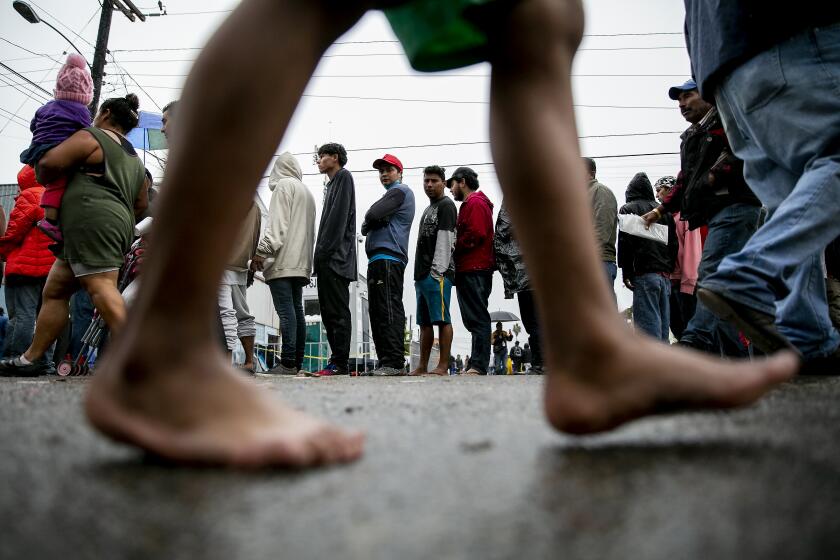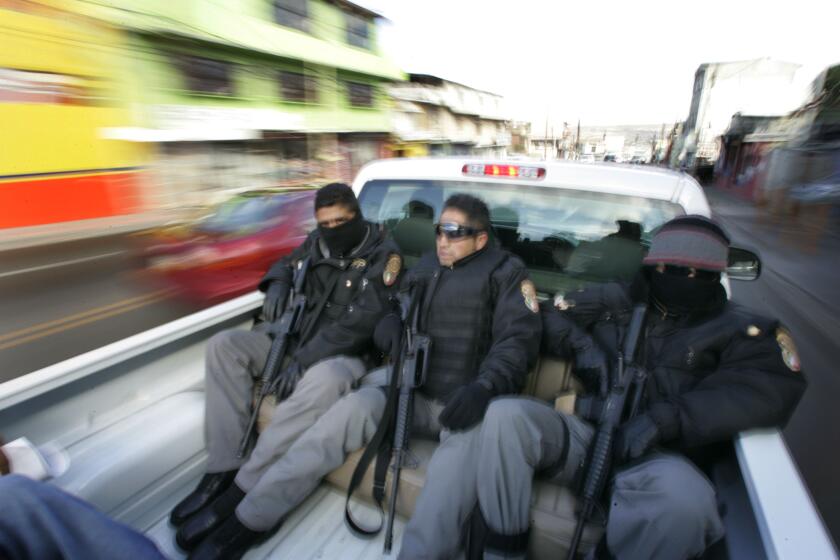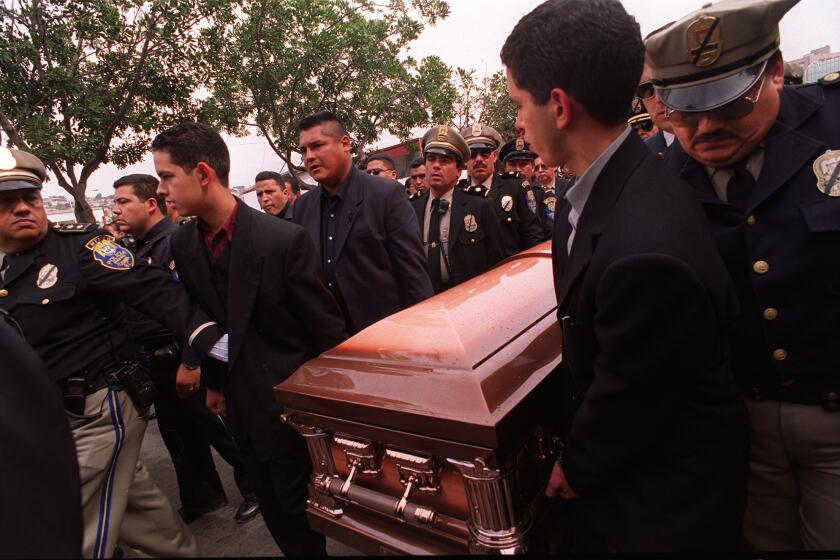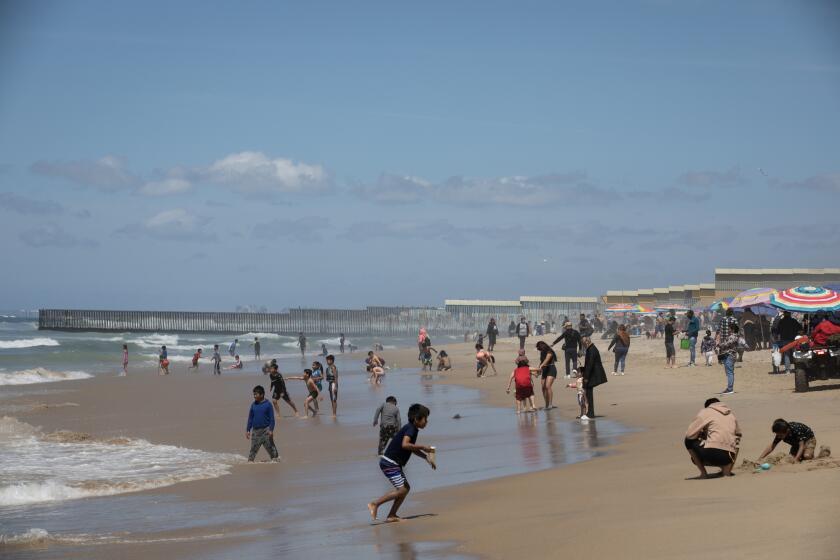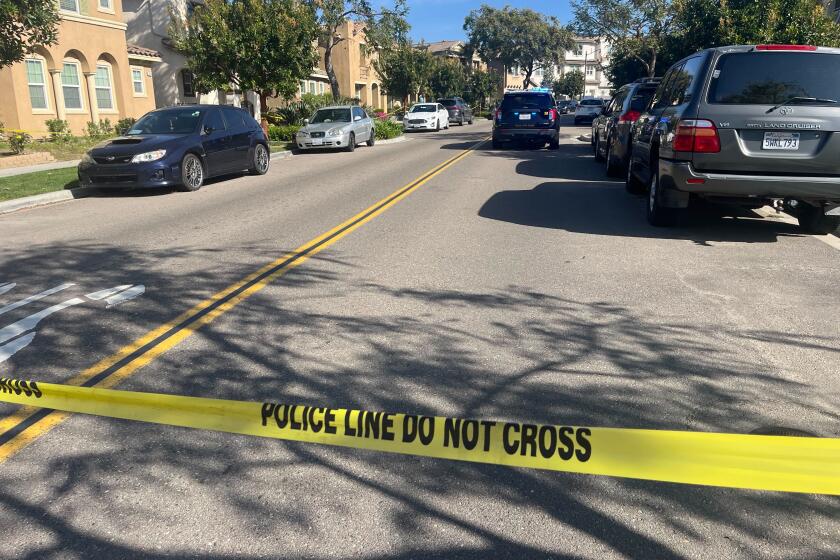Asylum for Mexican family in San Diego
Pablo Jaimes was working in the fields, so close to the road, he said, that he could hear the gunfire that took his youngest son’s life, and saw the police vehicle that sped away. A 20-year-old soldier in the Mexican army, Reynaldo Jaimes was on leave from a nearby base when gunmen ambushed his car, killing him and a fellow soldier.
That August afternoon in 2011 was just the beginning for the family from the state of Guerrero. Within two months, Jaimes’ 14-year-daughter was kidnapped and raped. Four months later, a second son who had also served in the military was found dead.
Deciding Mexico was no longer safe, the family fled. Now, more than two years after showing up at the San Ysidro border asking for mercy, Jaimes, 52, is on the verge of receiving asylum from the U.S. government, together with his wife, Mariana, 48, and four of their daughters.
“God has blessed us,” Jaimes said in a recent interview at a church in Vista.
The Jaimes are among a small minority of asylum applicants from Mexico who have prevailed through a lengthy process that demands not only firsthand testimony but extensive documentation of their claims. To succeed, they must prove a “well founded fear of persecution” on account of race, religion, nationality or membership of a particular social group.
The Jaimes said it was their sons’ direct knowledge of illegal government activity that not only cost them their lives but made the entire family a target of death threats.
“So many people have sad stories,” said Esther Valdes, the family’s attorney. The key for the Jaimes, she said, was that they were able to show “that not only was there persecution, but the government was involved in this without a shadow of a doubt.”
Their case comes as asylum requests have multiplied at the U.S. ports of entry — a sevenfold increase over the past three years, according to the Department of Homeland Security. Most have been applicants from Mexico and Central America.
Congressional critics of the U.S. asylum process say that many people without legitimate claims have abused the status as a way stave off deportation, buying time as they await asylum hearings, and often not showing up.
But others contend that the arrivals should not be so easily dismissed. “The reality is that there are a lot of reasons why people fear for their safety, and those claims need to be taken seriously,” said Keren Zwick, an attorney at the National Immigrant Justice Center in Chicago.
Though nowhere near the asylum acceptance rates for migrants from countries such as China, Iran, Iraq and Venezuela, rising numbers of Mexicans have been asylum in recent years.
Data from the Trans-Border Institute at the University of San Diego shows that of 7,775 asylum cases from Mexico decided by the U.S. government in 2013, 209 were granted in a non-adversarial process by U.S. asylum officers. Of the remaining cases, 155 were granted and 1,566 were denied by immigration judges after a formal hearing where the applicant was facing deportation. The rest were either withdrawn, abandoned or removed for other reasons.
“If you’re a prominent journalist or political prisoner, it’s easier to show that you’ve been personally targeted,” said Everard Meade, the institute’s director. “If you’re an ordinary person and you’ve been threatened, the cases are much more difficult.”
The Jaimes family, now living in North County, has persisted against difficult odds in more ways than one.
Last month, they received a notification letter from the Anaheim office of U.S. Citizenship and Immigration Services, part of the Department of Homeland Security: They and their four daughters are being recommended for approval. They are now awaiting final word, pending a routine background check.
Back in Mexico, the Jaimes lived in a rural community of some 400 houses called San Pedro Las Garzas, part of the municipality of Ajuchitlan del Progreso in the state of Guerrero. The region is part of the Tierra Caliente, or the Hot Land, an agricultural area also known for narcotics production — marijuana, heroin and methamphetamine
Violence in the area has continued since they left. Last week, armed gunmen grabbed a young a Catholic priest from a neighboring municipality, his body found days later in the river, the Rio Balsas. On Tuesday, a shootout ended with five people dead.
The family of 11 belonged to the local farming collective, or ejido, raising cattle, and growing corn, beans and squash. They picked avocados, oranges, mangos, selling them at the market. They had no desire to leave, Jaimes said: “We lived well, we were very much loved.”
But any sense of safety was shattered on that August afternoon in 2011.
The parents say their son Reynaldo was gunned down because of his military position, which included manning checkpoints and destroying drug crops. He had firsthand knowledge of police colluding with criminals, they said.
“He’d say, ‘I’m not leaving. If I get killed, so be it, but I am not going to betray my homeland,’” the father remembered. “He never allowed himself to be paid in exchange for his silence,” the mother recalled. “We just never thought that it would affect him in this way.”
No sooner had Reynaldo been buried than threatening calls began. But one was particularly disturbing, Pablo Jaimes said: “I am your friend and a friend of your son,” the man’s voice said. “Please leave San Pedro Las Garzas, because they’re preparing to kill you and your entire family.”
They immediately scattered. The second son, Elfego, also serving at the local military base, went into hiding in the city of Guadalajara with an aunt. Another son, Bertin, went to live with his in-laws in another part of the state. The Jaimes and their four daughters still at home moved to a community an hour and a half away, Cutzamala del Pinzon.
But telephone threats continued. And the month after they arrived, in October 2011, a 14-year-old daughter was kidnapped as she left school one afternoon. Though released after the parents reported the incident to authorities, the girl was badly shaken.
In February 2012, tragedy struck again. Elfego disappeared from his aunt’s house. Days later, his body, shot repeatedly, was found off a state highway in Guerrero. Pablo Jaimes only knew it was his son because of a tattoo with his initials. The family believes he was killed because he shared information with his brother.
But the killers were never caught. “The government, when it wants to, investigates and clears up matters, until it finds the criminals,” Pablo Jaimes said. “But the government didn’t do anything.”
That was when they made the decision to leave Mexico and ask for asylum in the United States. “No matter where we went, we were not going to be safe,” Pablo Jaimes said. “We had no choice but to come to this country.”
First to leave were was Bertin, along with his wife, children and the 14-year-old sister, crossing together April 2012, at the San Ysidro Port of Entry. That August, Pablo and Mariana Jaimes followed with the three other daughters, and their dead son Elfego’s wife and children.
“What distinguishes their case is that they made an attempt to escape, they even hid a son, and yet the persecution followed them,” said Valdes, their attorney. She knows of 17 others who fled San Pedro y Las Garzas, and represents six of them.
The Jaimes now live in a rented house in North County with relatives — they prefer not to say where, and asked that their daughters not be named. Pablo Jaimes has not found permanent employment but finds day jobs to help support the family, while a daughter, 20, works in a tortilla factory.
While their parents talked one recent afternoon, three daughters mostly listened quietly. Then they spoke of their own adjustment to their new home — how a passing truck would make them imagine that assassins were inside, or the sight of a police car caused them to wince in fear.
Life was good back in Mexico, said the 18-year-old, now studying accounting at community college. Until it wasn’t anymore.
sandra.dibble@utsandiego.com (619) 293-1716 Twitter: @sandradibble
Get Essential San Diego, weekday mornings
Get top headlines from the Union-Tribune in your inbox weekday mornings, including top news, local, sports, business, entertainment and opinion.
You may occasionally receive promotional content from the San Diego Union-Tribune.

